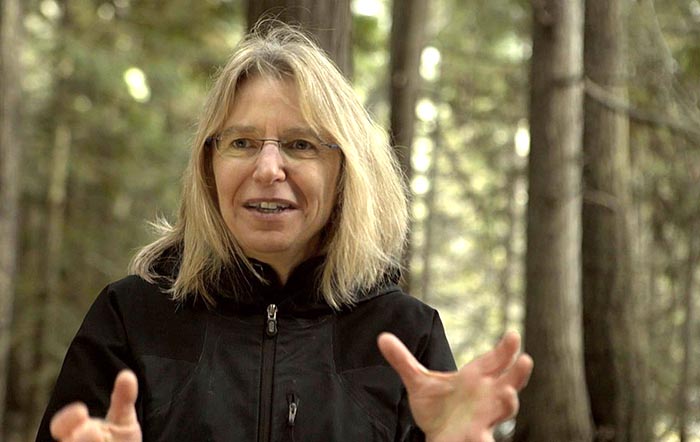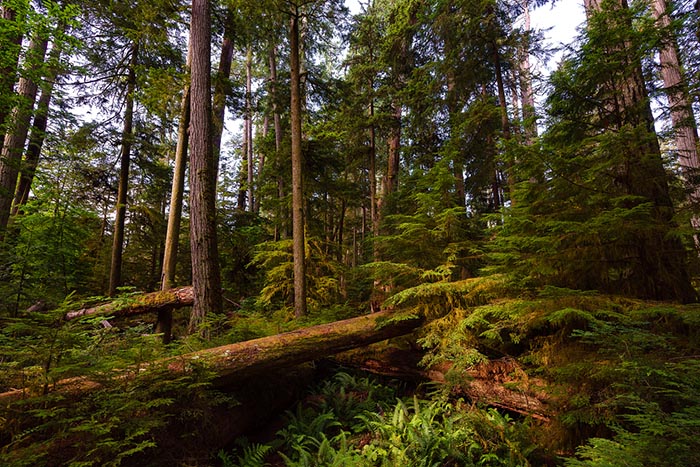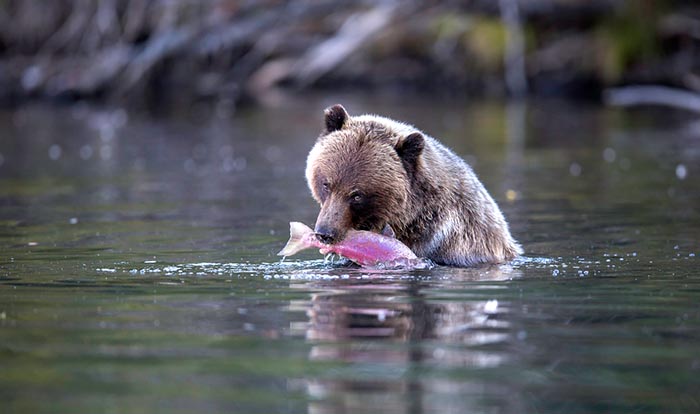News & Views
Review:
Finding the Mother Tree by Suzanne Simard
David Hyams reviews a recent book about the intelligence and cooperative behaviour of trees

Dr Suzanne Simard. Photograph: Wikimedia Commons
Dr Suzanne Simard is Professor of Forest Ecology at the University of British Columbia. She has gained a global reputation for her pioneering work on what has been called ‘the wood wide web’ – the discovery that trees communicate and help each other in an intelligent way. Her research to date has largely been presented through scientific papers accessible only to fellow scientists, but this book – subtitled ‘Uncovering the Wisdom and Intelligence of the Forest’ – is aimed at a general audience. It has proved to be hugely popular, and the rights have even been bought to make a Hollywood film!
In the Introduction, Simard reiterates the fundamentals of her scientific research over the last thirty years. This shows trees and plants as contributing to and being supported by ‘… a vast network of underground connections which joins young and old in perceiving, communicating and responding to one another by emitting chemical signals. Chemicals identical to our own neurotransmitters. Signals created by ions cascading across fungal membranes.’ [p.5, original italics] She describes the older trees ‘mothering their children, with Mother Trees as majestic hubs at the centre of forest communications.’ [p.5]
The book is autobiographical in several ways. Simard was born into a Québécois family living in the mountains of British Columbia, and generations of her ancestors earned a living felling trees. She is clearly motivated by a great love for the forests where she grew up, and a horror of the contemporary practice of clear cutting large areas, leaving just upturned stumps. She describes how she negotiated her way through the logging industry in order to carry out her scientific research, tucking her more controversial experiments in among mainstream ones when applying for grants. The book is also the personal story of her love for her family and friends, the changing relationships between them and bringing up her children to experience and understand the ways of the forest. She paints pictures in colloquial language, throwing in the occasional exclamation in Québécois French.

Cathedral Grove on Vancouver Island, British Columbia, a rare and endangered remnant of the ancient Douglas fir ecosystem. Photograph: Unai Arnaz Imaz/iStock
Discovering the Communication Network.
But the meat of the book is in the detailed descriptions of her scientific experiments, which she describes in a way which is both accessible to a layman and also conveys the excitement of discovery. For example, in Chapter 8, entitled ‘Radioactive’, she describes how she and a colleague prepared the key field experiment in her doctoral research programme. It aimed to establish whether birch saplings cooperate with young Douglas firs. Conventional wisdom – fiercely defended by government and the logging industry – had it that broad leafed birch would shade the firs, stunting their growth. This was their argument for clear cutting. But Simard asked: could it be that the birch produced enough sugar through photosynthesis that it could afford to share some with its neighbouring firs through underground networks of mycorrhizal fungi? If so, both species should thrive better if they were allowed to grow together. What is more –
If carbon did transmit between tree species, this would present an evolutionary paradox, since trees are known to evolve through competing, not cooperating. On the other hand, my theory was entirely plausible to me, because it made sense that they would have a selfish interest in keeping their community thriving, so that they could get their needs met too. [p.145]
In the early 1980s, Professor Sir David Read of Sheffield University, UK had established that under lab conditions cooperation between plants of the same species occurred. It had also been established that trees communicated through their roots, often aided below ground level by fungal networks. Now Simard wanted to go further, looking at cooperation between species. In the first year of her experiment she sunk sheet metal bands into the ground to define small root level enclosures for the test samples she had planted in groups of three seedlings – a fir, a birch and a cedar. The experiment consisted of 60 groups covering an area roughly the size of an Olympic swimming pool. The seedlings were each shaded by a pyramid-shaped tent using porous fabrics of varying opacity to simulate shading.
Simard returned sometime later to measure photosynthesis levels in her samples. Next, randomly selected sample seedlings were individually encased above ground in a clear plastic bag, and each bag was injected with a dose of radioactive gas. Carbon-13 was given to the firs and carbon-14 to the birch. Cedar was used as a control because it is known not to communicate in the same way as birch and fir. This meant that later, the levels and type of radioactivity in each seedling could be traced and measured.
She dug up root samples and spent several long days grinding them into powder in a fume hood, before sending the powders away for analysis. Only later did she realise that she had put herself at risk by not having fitted her dust mask properly.
When the field carbon-transfer data came in from the lab, I held my breath. This was it. The science was sound. The experiment had taken every variable into account…. I sat in disbelief. Birch and Douglas fir were trading carbon back and forth through the network. Even more stunning, Douglas fir received far more carbon from birch than it donated in return…. The trees were connected, cooperating.
I was so shaken I leaned against the wall of my office to absorb what was unfolding, because the earth seemed to be rumbling…. They were working together like a system. An intelligent system, perceptive and responsive. Roots didn’t thrive when they grew alone. Trees needed one another. [pp.160–61)
At this point, the phone rings with news of a shocking family tragedy.

A grizzly bear eating a sockeye salmon, British Columbia. Simard reveals that the bears play an essential role in the maintenance of the forests. Photograph: TDImage/iStock
Interconnectivity.
In the final chapter, Simard tells a story which clearly demonstrates the connectivity between different elements in the traditional eco-system – animals, fish, earth, water and transport through fungal networks. It happened when she visited an island under the traditional stewardship of the Heiltsuk tribe. In their party was Dr Teresa ‘Sm’hayetsk’ Ryan, an indigenous person and a scientist of the Tsim-shian Nation with an interest in salmon fisheries and in cedar bark for basket weaving. Also in the group were two academics who had detected nitrogen in the tree rings of cedars and sitka spruce. The Heiltsuk maintain traditional fish traps that allow only large mature salmon to swim upstream to breed. Grizzly bears feed on the spawning salmon, leaving quantities of bones behind on the ground. These then leach nitrogen into the soil, and the levels can be measured through analysis of nitrogen showing up in tree rings.
There is a passage where she describes crawling, with a colleague, through the undergrowth for some time, aware that a grizzly mother and cubs had recently passed that way and hoping not to bump into them. ‘“Putain de merde!” I shouted, “Look!” Under the boughs of old Mother Tree was a cosy, mossy bed, large enough for mama bear and her cubs. Dozens of white salmon skeletons gleamed from the carpet ….’ [p.291] They collected soil from around the bones to take back to the lab for analysis, and managed to show that the mycorrhizal fungal community differs depending on the number of salmon returning to their natal streams. This is new knowledge for Western science, but the indigenous people ‘knew how vital salmon was to the interior forests, and to their livelihoods, and they’d cared for the populations according to far-reaching principles of inter-connectness.’ [p.293] (For more on the traditional forest ecology of indigenous peoples of British Columbia, see our article on the native elder Wax’aid.)
The lesson Simard takes from all this is that we must learn from forest ecology how to regulate our own conduct. The book’s title – referring to the wisdom of trees – suggests that her life’s work leads directly to her ambitious next piece of research, The Mother Tree Project [/]. Set over nine sites across British Columbia, chosen for their range of altitude, geology and climate, she aims to establish the science that will support a new forest management style encouraging collaboration as well as competition. She links this work to the management of global carbon dioxide levels and the battle to control increasing global warming. In her introduction, she tells us, ‘This is not a book about how we can save the trees. This is a book about how the trees might save us.’ [p.6]
For a brief outline of Simard’s discoveries, see this 2016 TED talk:
Video: How Trees Talk to Each Other. Duration: 18:10
For more on the book and the relevance of her ideas to the current situation, see this interview with Catherine Chien:
Video: Finding the Mother Tree. Duration: 58:28

SUZANNE SIMARD, Finding the Mother Tree; Uncovering the Wisdom and Intelligence of the Forest was published by Allen Lane in 2021.
More News & Views
Poems for These Times: 18 – New Year 2024
Benjamin Zepahniah | Faceless
“You have to look beyond the face
to see the person true
Down within my inner space
I am the same as you…”
Introducing… ‘Tiger Work’ by Ben Okri
Barbara Vellacott reads from and discusses a new book of stories, parables and poems about climate change
Book Review: “Elixir: In the Valley at the End of Time” by Kapka Kassabova
Charlotte Maberly reviews a book about the search for wholeness, and a heartfelt plea to reclaim our spiritual, physical and emotional unity with nature
Book Review: “Work: A Deep History” by James Suzman
Richard Gault reviews a new book which takes a radical approach to contemporary work culture
Introducing… Bernardo Kastrup and Swami Sarvapriyananda
Charlotte Maberly appreciates a wide-ranging video conversation about Eastern and Western concepts of the self and mind
Connecting Threads on the River Tweed
Charlotte Maberly investigates an innovative project which explores cultural engagement as the driver of ecological change
FOLLOW AND LIKE US
——————————————
——————————————
——————————————
If you enjoyed reading this article
Please leave a comment below.
Please also consider making a donation to support the work of Beshara Magazine. The magazine relies entirely on voluntary support. Donations received through this website go towards editorial expenses, eg. image rights, travel expenses, and website maintenance and development costs.
READERS’ COMMENTS
1 Comment
Submit a Comment
FOLLOW AND LIKE US
Fascinating – where will it take us?